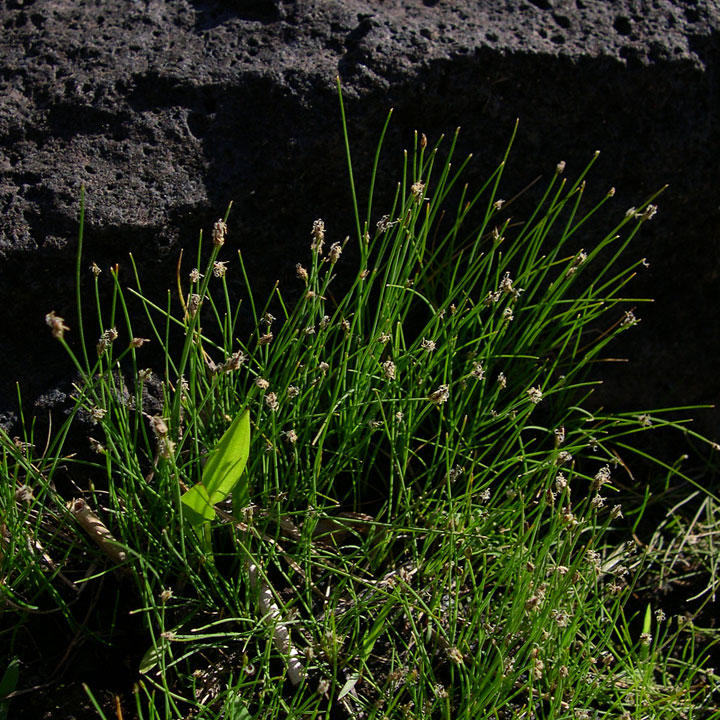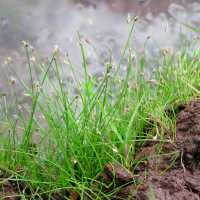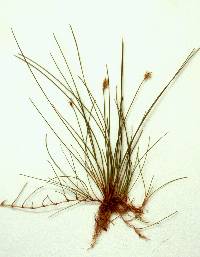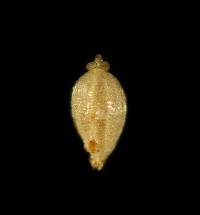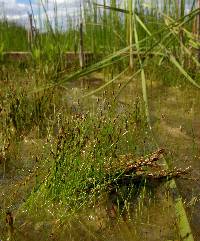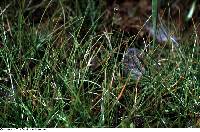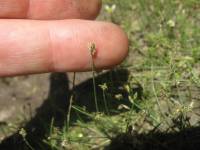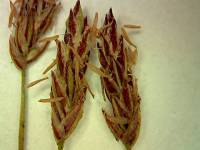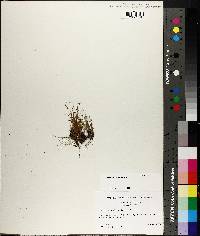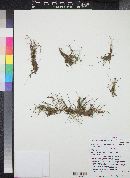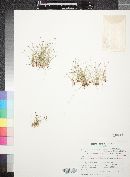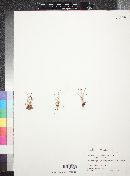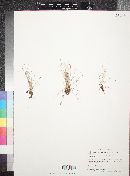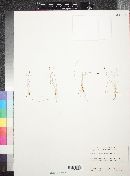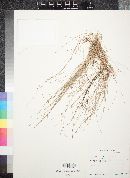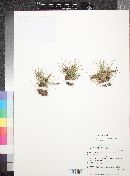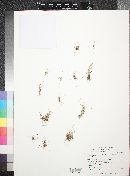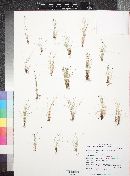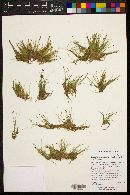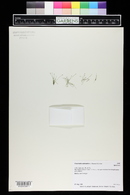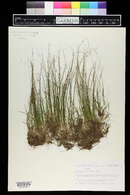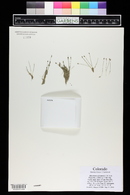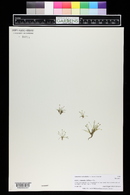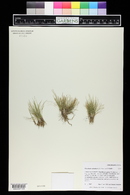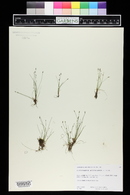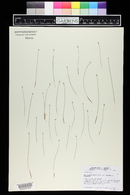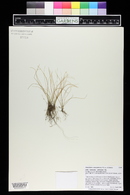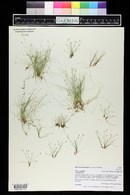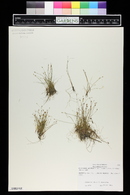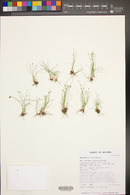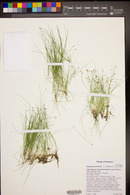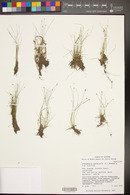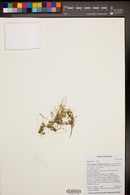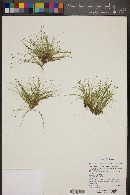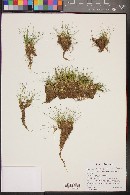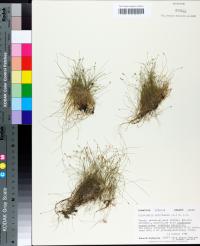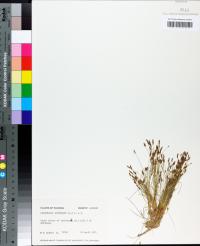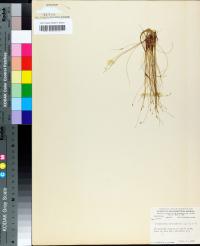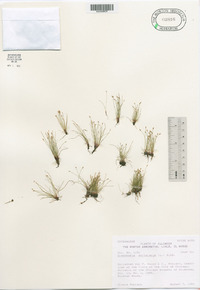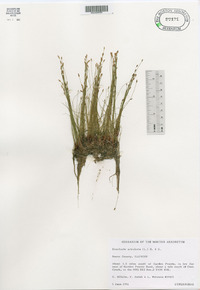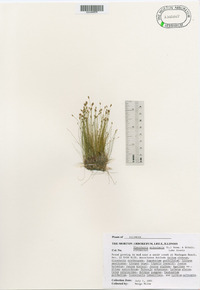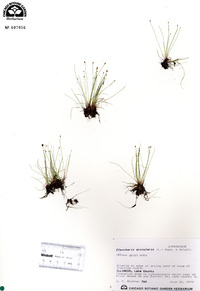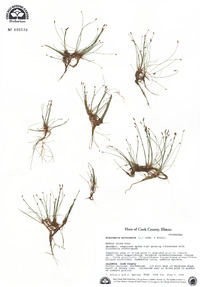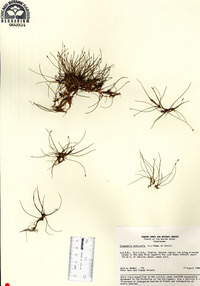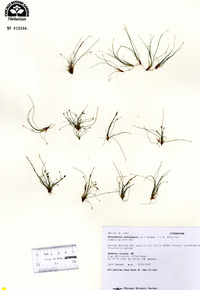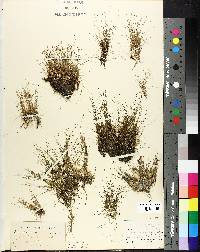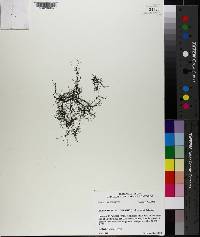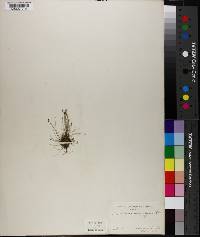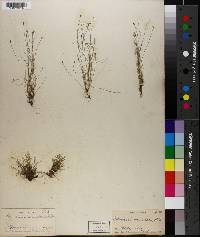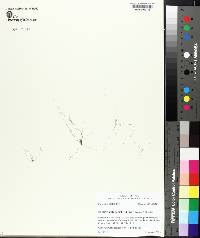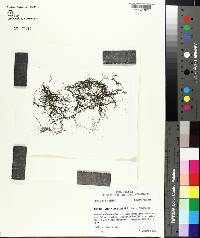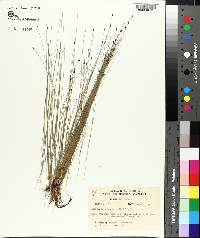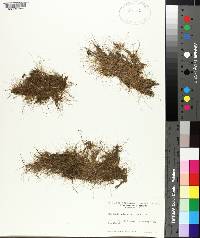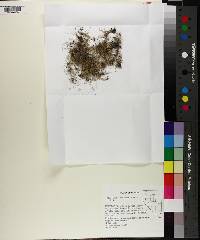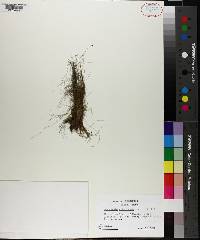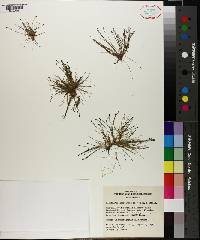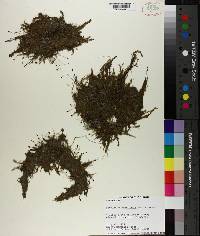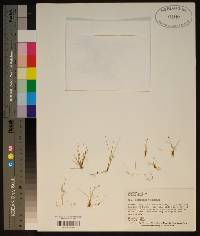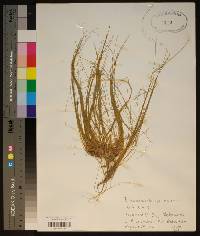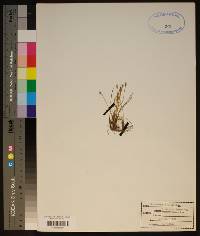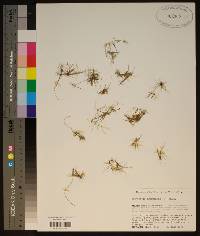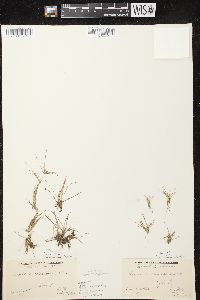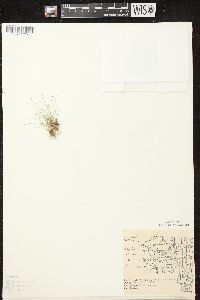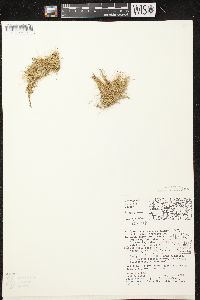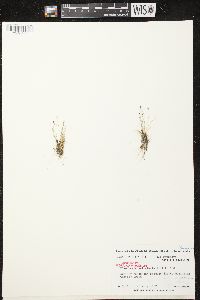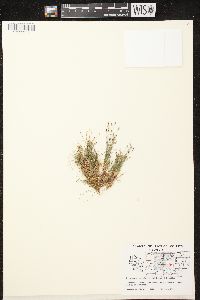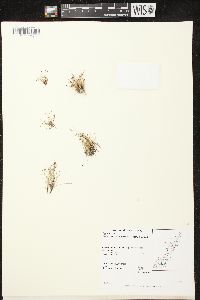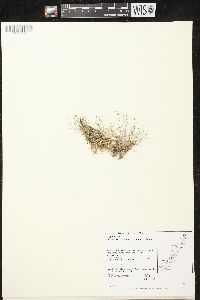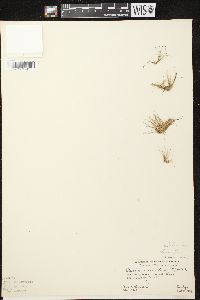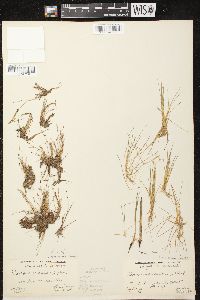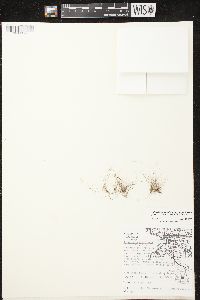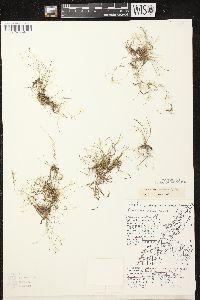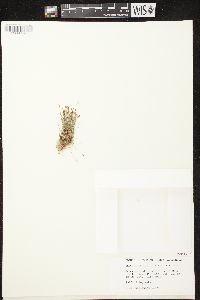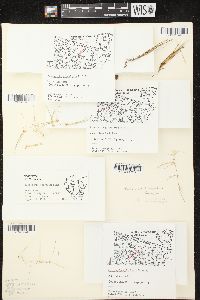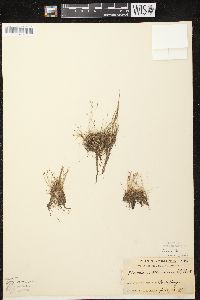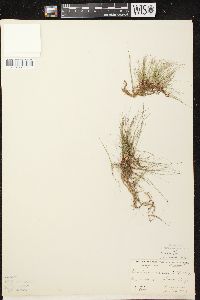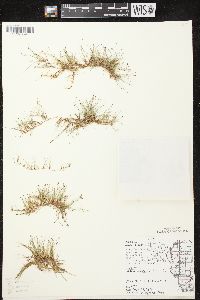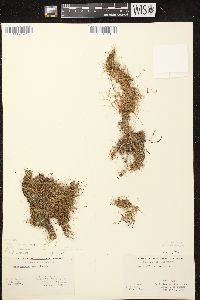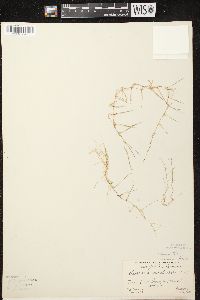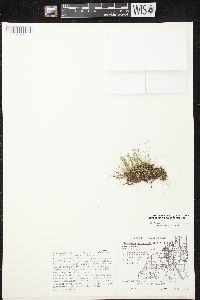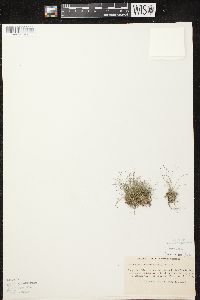
|
|
|
|
Family: Cyperaceae
Needle Spike-Rush, more...needle spikerush, needle spikesedge
[Scirpus acicularis L.] |
Plants perennial; rhizomes 0.25-0.5 mm thick, internodes 5-15 mm, scales fugaceous, rarely evident, translucent, 2 mm. Culms sometimes arching, smooth or 3-12-ridged, terete to sometimes distinctly compressed, 1-60 cm × 0.2-0.5(-0.7) mm, flaccid to rigid. Leaves: distal leaf sheaths persistent or fugaceous, proximally stramineous to red, distally colorless to stramineous or whitish, closely sheathing to prominently inflated, often splitting adaxially, apex rounded (to acute). Spikelets ovoid to lanceoloid or subcylindric, 2-8 × 1-2 mm, apex acute; floral scales 4-25, 4-6 per mm of rachilla, bright reddish or purplish brown to stramineous, midrib region often green, ovate, 1.5-2.5(-3.5) × 1-1.5 mm, midrib prominent to obscure, apex blunt to acute. Flowers: perianth bristles mostly absent, uncommonly 2-4, whitish to pale brownish, slender, obscurely retrorsely and spreading-spinulose, shorter than to equaling achene; stamens 3; anthers yellow to brown, 0.7-1.5 mm. Achenes with angles plus longitudinal ridges ca. 8-12, obscure to prominent, narrowly to broadly obovoid to obpyriform, 2 times to much less than 2 times longer than wide, 0.7-1.1 × 0.35-0.6 mm, trabeculae 30-60, clearly evident to crowded and obscure, spaces between trabeculae sometimes translucent. Tubercles gray to greenish or brownish, pyramidal to much depressed, (0.05-)0.1-0.2 × 0.15-0.25 mm. 2n = 20. Fruiting spring-fall. Bare, wet soil or in fresh (rarely brackish) lakes, ponds, vernal pools, meadows, springs, disturbed places; 0-3300 m; Greenland; Alta., B.C., Man., N.B., Nfld. and Labr., N.W.T., N.S., Nunavut, Ont., P.E.I., Que., Sask., Yukon; Alaska, Ariz., Ark., Calif., Colo., Conn., Del., D.C., Ga., Idaho, Ill., Ind., Iowa, Kans., Ky., La., Maine, Md., Mass., Mich., Minn., Miss., Mo., Mont., Nebr., Nev., N.H., N.J., N.Mex., N.Y., N.C., N.Dak., Ohio, Okla., Oreg., Pa., R.I., S.C., S.Dak., Tenn., Tex., Utah, Vt., Va., Wash., W.Va., Wis., Wyo; Mexico; Central America; South America (Ecuador); Eurasia; Australia (probably introduced). Eleocharis acicularis is abundant and ecologically important throughout much of its range. It occurs in a wide variety of habitats, including acid waters. I have not seen voucher specimens for reports from Alabama and Florida. I have not seen vouchers for the reported chromosome numbers of 2n = 30-38 or 50-58. Eleocharis acicularis often forms large rooted mats or floating masses, which when submerged, are often non-flowering. Submerged, usually nonflowering plants are abundant throughout much of the range of the species (H. K. Svenson 1929; P. E. Rothrock and R. H. Wagner 1975). They have been called E. acicularis forma fluitans (Doellinger) Svenson; E. acicularis forma inundata Svenson; E. acicularis forma longicaulis (Desmazières) Hegi; E. acicularis forma submersa (Nilsson) Norman; and E. acicularis var. submersa (Nilsson) Svenson. The culms of the submerged plants are terete, smooth, soft to flaccid, translucent, and the partitions of the air cavities within are clearly visible. Submerged plants may closely resemble aquatic forms of some other species, especially Eleocharis parvula, E. robbinsii, and Schoenoplectus subterminalis (Torrey) Sojak (N. C. Fassett 1957; E. G. Voss 1967, 1972-1996, vol. 3). Although E. acicularis is very variable, recognition of varieties is premature pending a worldwide taxonomic revision of subg. Scirpidium. Much of the variation is apparently due to phenotypic plasticity in response to environmental factors, especially water depth (P. E. Rothrock and R. H. Wagner 1975). The named varieties intergrade extensively, and achenes, which are important in defining the varieties, are often absent. H. K. Svenson (1929) recognized four varieties and two forms for North America, but later (1957) did not recognize infraspecific taxa. Most plants from the Arctic to cool-temperate North America, including higher elevations in the Southwest, are very similar to plants from northern Europe and presumably belong to typical E. acicularis, which was described from Europe. Those plants have culms cylindric or three- to four-angled; leaf sheaths mostly obscure and closely sheathing; and achenes about two times longer than wide. Eleocharis acicularis var. gracilescens Svenson, type from St. Louis, Missouri, applies to plants with flowering culms unusually long (to 60 cm), smooth or sometimes with five to twelve fine ridges, their bases not cormlike; spikelets often linear-lanceoloid, often unusually long (to 8 mm); floral scales often unusually long (to 3.5 mm), often stramineous; and achenes much less than two times longer than wide. Plants of E. acicularis var. gracilescens are probably usually emergent in shallow water; they are known from scattered collections from Alabama, Florida, Kansas, Missouri, North Dakota, Oklahoma, South Carolina, Tennessee, and Texas. Robust plants of E. acicularis var. gracilescens are sometimes misidentified as E. wolfii. H. K. Svenson (1957) stated that var. gracilescens may be distinct from E. acicularis. Some specimens from California and Oregon that resemble E. acicularis var. gracilescens may be ecologic forms of E. acicularis var. occidentalis. Eleocharis acicularis var. occidentalis Svenson, type from Santa Barbara, California (illustrated in H. L. Mason 1957; H. K. Svenson 1939, plate 539), applies to plants with culms only 2-6 cm, smooth or usually some prominently four-angled or finely to ca. eight-ridged, their bases often persistent, swollen, and cormlike (illustrated herein); distal leaf sheath summits mostly evident, often markedly inflated; achenes much less than two times longer than wide. This variety often grows in vernal pools. As here defined, it is known only from Arizona, California, and Nevada. Most of the specimens H. K. Svenson (1929) cited in the protologue and identified on herbarium specimens as E. acicularis var. occidentalis are probably referable to typical E. acicularis. Eleocharis acicularis var. porcata S. G. Smith (S. G. Smith 2001), type from Texas, applies to plants that are similar to E. acicularis var. occidentalis except that their culms (cross section illustrated herein) reach 22 cm × 0.5 mm, some or all are prominently six- to twelve-ridged and mostly distinctly compressed, and their bases are not cormlike. This variety grows in mud and shallow water of marshes, ponds, and stream margins; it is known from Alberta, Arizona, Colorado, Illinois, Kansas, Louisiana, Nebraska, New Mexico, North Dakota, and Texas. Because of their compressed, prominently-ridged culms, robust plants of E. acicularis var. porcata, including a paratype of E. wolfii, are sometimes misidentified as E. wolfii (S. G. Smith 2001).
Perennial herb with slender rhizomes, often forming extensive mats 1 cm - 0.6 m tall (elongated in deep water) Leaves: reduced to bladeless sheaths, basal, two per culm, margins fused and enclosing culm, often splitting, straw-colored or reddish basally, with a rounded apex. Flowers: minute, spirally arranged on the axis of the spikelet, lacking sepals and petals, with zero or two to four bristles, subtended by a scale. Bristles (when present) whitish to pale brown, equal to or shorter than the achene, slender. Stamens three, exserted. Anthers brown or yellow, to 1.5 mm long. Pistil one. Style three-cleft. Fruit: a one-seeded achene, white to pale gray or pale yellowish, about 1 mm long and 0.5 mm wide, reverse egg-shaped to reverse pear-shaped, three-angled (angles rounded), with about eight to twelve longitudinal ridges and many transverse cross-ridges. Tubercle tiny, more or less pyramidal or depressed. Seed with a thin, non-adherent wall. Culm: sometimes arching, unbranched, 1 cm - 0.6 m long, to 0.5 mm wide, circular in cross-section to compressed, smooth or three- to twelve-ridged, solid, enclosed basally by two fused sheaths. Spikelets: solitary, 2 - 8 mm long, 1 - 2 mm wide, egg-shaped to nearly cylindrical with a pointed apex, with four to twenty-five floral scales. Scales spirally arranged and overlapping, straw-colored to reddish brown with a green midrib, 1.5 - 2.5 mm long, 1 - 1.5 mm wide, egg-shaped with a blunt to pointed apex, membranous. Similar species: No information at this time. Flowering: mid-May to early October Habitat and ecology: Locally frequent in marshes and in muddy areas. Also found in very springy calcareous places. May be found submersed in the water or on the shore. Occurence in the Chicago region: native Etymology: Eleocharis comes from the Greek words heleios, meaning "dwelling in a marsh," and charis, meaning grace. Acicularis means needle-shaped. Author: The Morton Arboretum Diminutive, very slender perennial, commonly forming dense tufts on slender rhizomes; stems 3-12 cm, filiform, up to 0.25 mm thick; spikelet 2.5-7(-9) mm, 3-15- fld; scales (1.3-)1.5-2.2 mm, with a greenish midrib and ±hyaline, paler or partly anthocyanic margins, the basal one floriferous; bristles mostly 3 or 4, equaling or surpassing the achene, or reduced or obsolete; anthers 0.7-1.3 mm (dry); style trifid; achene white to pale gray or faintly yellowish, 0.7-1 mm, rounded-trigonous, longitudinally 8-18-ribbed and with very numerous fine, straight cross-ridges; tubercle short, ±triangular-conic; 2n=20-58. Marshes, muddy shores, and other wet places; circumboreal, s. to Fla. and Mex. Gleason, Henry A. & Cronquist, Arthur J. 1991. Manual of vascular plants of northeastern United States and adjacent Canada. lxxv + 910 pp. ©The New York Botanical Garden. All rights reserved. Used by permission. From Flora of Indiana (1940) by Charles C. Deam In the muddy or sandy bottoms or borders of ditches, sloughs, streams, and lakes. Sometimes on the springy marl; borders of lakes. ...... Indiana Coefficient of Conservatism: C = 2 Wetland Indicator Status: OBL |
|
|
|
This project was made possible in part by the Institute of Museum and Library Services [MG-70-19-0057-19].
Powered by Symbiota

